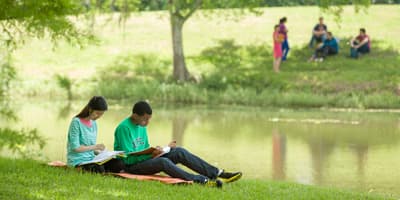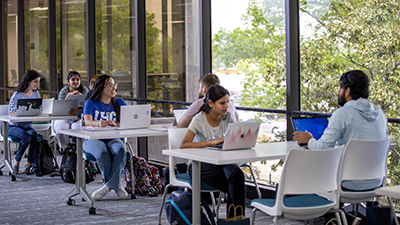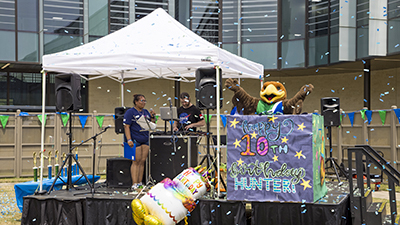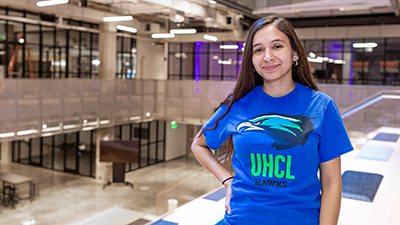Student's skill with drones takes chicken turtle research to new heights
By: Katherine Adams

The best way to understand how college students use drones to advance critical science and research is to get someone like Jason Nagro to explain how he uses them. He’s been FAA-trained and licensed to fly sUAS, or small unmanned aerial systems, and he uses his skills to learn all he can about an elusive, yet critical wetland-dwelling species—the Western Chicken Turtle.
Nagro finished his undergraduate degree at the University of Oregon and came to University of Houston-Clear Lake to begin his Master of Science in Environmental Science, and was offered a position through the Environmental Institute of Houston as a field technician. Then, he was brought on as a research assistant to work on a study focused on the distribution and habitat of the Western Chicken Turtle in Texas.
“This species is found throughout east Texas, and prefers wetlands that dry up during the warmer parts of the year, this is when they bury themselves in the ground,” Nagro explained. “They are reliant upon environmental conditions, so they’re a good species to study to infer what is going on with the overall habitat of these areas. If any part of the pyramid is skewed, the chicken turtles will suffer.”
The study is funded by the Texas Comptroller of Public Accounts and drones are a big part of how he collects the needed data. “Our job is to go to the places where chicken turtle habitats might be, and find the best methods for detecting them,” he said. “We have employed a lot of methods—walking and driving surveys, using binoculars, and trapping methods using cameras and hoop nets. We have even used wildlife service dogs to track their scent.”
The goal is to find environmental DNA that indicates the turtles are there, or are nearby. “We look for anything that leaves traces of DNA, like tissue, feces, or parts of the shell,” he said. “We collect samples of the water and soil, then cross reference them with a DNA primer specific to chicken turtles, and determine if they’re present or not.”
Using the drone, Nagro said he plots a “transect” or a flight plan, where the drone will fly, and it records videos, takes still photos and multi-spectrum images, and provides data from a thermal sensor.
“A majority of turtle research done with drones comes from sea turtles and their nesting on beaches, where there’s no overhanging trees,” he said. “With the affordability and small size of these drones, we’re able to transition into freshwater environments where there is vegetation and overhanging trees that can be obstacles in the area, which can make flying challenging.”
Since the species is quite cryptic, he said his goal was to assess whether it was better to continue using the drones over the more traditional methods, and how effective the data is for the study on chicken turtles.
“That brings us to the ultimate question, which is how best to find them in the first place,” he said. “I’ve taken over the drone aspect of the study, comparing each of the methods to the other.”
He’s reviewed about 25 hours of film and tens of thousands of photos to find the turtles and created a data base to which he will apply statistics and other analyses. “A great benefit to using drones is that they’re less invasive,” he said. “Instead of walking through a natural habitat that you could destroy, the drone simply occupies some air space and is not interacting directly with anything.”
All drone-collected evidence can be reinvestigated and replayed, which is another great benefit. “It’s much better than using binoculars,” he said. “I’ve found a few chicken turtles using the drones, but the biggest difference between this and using other methods is that we can always replay the data. And while I’m getting that information, the drone is also collecting data on trees and other wildlife in the area that I can compile later.”
He added that his proficiency with drones will enhance his appeal to potential employers when he enters the job market. “That’s one reason why I took this on,” he said. “Funding in the environmental field is difficult, but my ability to use this technology increases the value of my skill set.”
Nagro said his interest in amphibians and reptiles are in part what drew him to UH-Clear Lake from his home in San Diego, California.
“The southeast is a hot spot in the U.S. for studying those species,” he said. “There’s a lot of diversity here. The campus’s natural setting and beauty is a big reason why I wanted to come here. I get to see armadillos and alligators, which are two of my favorite things, in the bayou and in Potter Pond nearly every day. Having this opportunity to be a research assistant was really a lucky catch for me.”
The Environmental Institute of Houston at UHCL leads numerous environmental research initiatives that impact our community. Learn more online.







